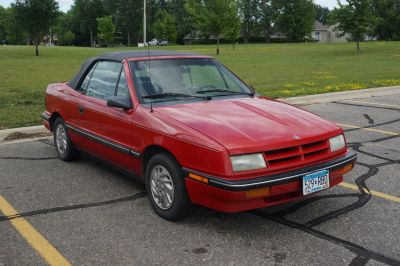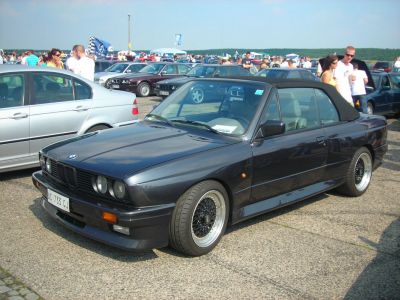 1983 Porsche 911 Cabriolet (G) Dimensions, Size & Specs
1983 Porsche 911 Cabriolet (G) Dimensions, Size & SpecsMeasurements of the 1983 Porsche 911 Cabriolet, engineered for optimal performance and comfort
| Dimensions | |
|---|---|
| Length: | 4291 mm168.9 in14.1 ft |
| Width: | 1652 mm65.0 in5.4 ft |
| Height: | 1320 mm52.0 in4.3 ft |
| Ground Clearance: | 130 mm5.1 in0.4 ft |
| Weight Specifications | |
| Curb Weight: | 1250 kg2756 lbs |
| Tire Specifications | |
| Rims Sizes: | 15-inch rims:
|
| Tire Sizes: |
|
The Porsche 911 Cabriolet (G) generation, produced between 1982 and 1989, is an iconic open-top sports car known for combining classic Porsche design with spirited driving dynamics. Specifically, the 1983 model year showcases a balance between compact dimensions and lightweight construction, echoing Porsche's commitment to performance and style.
With a length of 4291 mm (168.9 inches), a width of 1652 mm (65 inches), and a height of 1320 mm (52 inches), the 911 Cabriolet (G) retains a sleek and aerodynamic profile ideal for both street driving and spirited open-air cruising. Its relatively low ride height of 130 mm (5.1 inches) enhances handling agility by lowering the center of gravity, contributing to the classic Porsche driving experience.
Weighing in at 1250 kg (2,755 lbs), this generation of the 911 Cabriolet manages to be light enough for responsive acceleration while offering the structural reinforcements necessary for an open-roof configuration. The rim sizes of 7J x 15 and 6J x 15 paired with respective tire sizes ranging from 215/60 R15 to 185/70 R15 provide a balanced setup for grip, comfort, and handling.
The 911 Cabriolet (G) remains a celebrated model within Porsche's 911 lineage, showcasing a fine blend of design ingenuity, compact engineering, and classic open-air motoring. Its dimensions make it a comfortable yet agile sports car, suitable for enthusiasts who appreciate a timeless design with a direct connection to the road.
Discover the standout features that make the 1983 Porsche 911 Cabriolet a leader in its class
Have a question? Please check our knowledgebase first.
The Porsche 911 Cabriolet (G) produced between 1982 and 1989 has a length of 4291 mm (169 inches), a width of 1652 mm (65 inches), and a height of 1320 mm (52 inches). These compact dimensions reflect its classic sports car design, making it relatively easy to maneuver and park compared to larger vehicles, while maintaining the iconic 911 silhouette with a cabriolet open-top configuration.
The curb weight of the Porsche 911 Cabriolet (G) from 1983 is approximately 1250 kg (2755 lbs). This moderate weight contributes to the car’s agile handling characteristics typical of the 911 lineage. The relatively low weight enhances acceleration, braking, and cornering performance, especially when combined with the rear-engine layout and the responsive suspension setup.
The ride height (ground clearance) of the 1983 Porsche 911 Cabriolet (G) is 130 mm (5.1 inches). This low ground clearance is typical for sports cars, optimizing aerodynamics and stability at higher speeds. However, it means owners need to be cautious on uneven roads, speed bumps, and ramps to avoid scraping the undercarriage.
This generation of Porsche 911 Cabriolet uses rims sized 7J x 15 at the front and 6J x 15 at the rear. The tire sizes include 215/60 R15, 185/70 R15, and 195/65 R15. These tire and rim combinations provide a balance of grip, ride comfort, and classic visual proportions, supporting the car’s sporty handling characteristics.
Yes, the Porsche 911 Cabriolet (G) fits comfortably into a standard residential garage. With a length of 4291 mm (169 inches), width of 1652 mm (65 inches), and height of 1320 mm (52 inches), it is smaller than many modern cars and SUVs. Most standard garages, which typically measure around 2400-3000 mm (94-118 inches) wide and at least 4800 mm (189 inches) deep, will easily accommodate the car with space to spare.
Compared to its predecessor, the Porsche 911 Cabriolet (from the earlier 911 SC or 3.2 Carrera models), the (G) generation retains very similar exterior dimensions. The length, width, and height differences are minimal, as Porsche focused on evolutionary styling rather than radical size changes. Weight may have slightly varied due to additional features and safety equipment, but the overall compact and lightweight sports car character remained consistent across the transition.
In the early 1980s, many sports cars like the BMW M1, Ferrari 308, or the Datsun 280ZX had comparable lengths, but the Porsche 911 Cabriolet (G) was narrower and lower in height. This smaller width (1652 mm vs. 1800 mm+ for some rivals) and low height at 1320 mm contribute to its nimble handling and lower aerodynamic drag. The 911’s distinctive shape and compact footprint distinguished it from bulkier competitors and underscored its identity as a pure driver's car.
The Porsche 911 Cabriolet (G) from 1983 is designed as a 2+2 sports car, meaning it has two front seats and two smaller rear seats. While the front seats provide a comfortable, sporty driving position, the rear seats are relatively compact and best suited for occasional use or children. The interior emphasizes driver engagement and cockpit feel over spaciousness, aligning with the car’s sporting intentions rather than family convenience.
The 1983 Porsche 911 Cabriolet (G) is powered by the classic air-cooled flat-six engine, offering a blend of smoothness and typical 911 sound. While specific power outputs varied by model and market, the car delivered spirited acceleration and sharp handling thanks to its rear-engine, rear-wheel-drive layout, and well-tuned suspension. It showcased Porsche’s engineering philosophy of high-performance driving with timeless style and open-air experience thanks to the cabriolet design.
For its era, the 1983 Porsche 911 Cabriolet (G) included safety features such as reinforced doors, seat belts, and crumple zones designed to enhance occupant protection. However, it lacked modern amenities like airbags and advanced electronic safety systems. Convenience features were relatively basic, focusing on functional design with manual controls, but the Cabriolet offered the pleasure of open-top driving combined with classic Porsche craftsmanship and build quality.
Discover similar sized cars.

| Production: | 1986-1995 |
|---|---|
| Model Year: | 1987 |
| Length: | 4360 mm171.7 in |
| Width: | 1710 mm67.3 in |
| Height: | 1370 mm53.9 in |

| Production: | 1988-1991 |
|---|---|
| Model Year: | 1988 |
| Length: | 4345 mm171.1 in |
| Width: | 1680 mm66.1 in |
| Height: | 1370 mm53.9 in |
